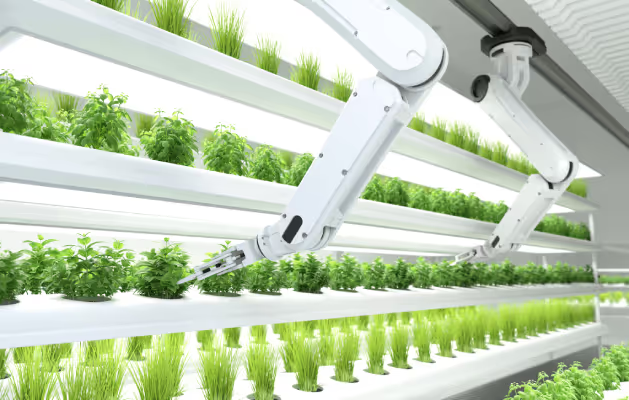
Automation in Vertical Farming
Vertical farming has emerged as one of the most innovative solutions to address challenges posed by urbanization, limited arable land, and climate change. By utilizing controlled environments and maximizing space through multi-layered systems, vertical farms provide a sustainable method for growing various crops in urban settings. However, the full potential of vertical farming can only be realized through the integration of automation. Automated technologies in vertical farming are transforming the industry by improving efficiency, reducing costs, increasing yields, and ensuring consistency and crop quality.
What is Vertical Farming?
Vertical farming refers to the practice of growing plants in vertically stacked layers or on inclined surfaces in controlled indoor conditions. These systems can be located in warehouses, greenhouses, or even shipping containers. Vertical farms utilize hydroponics, aeroponics, or aquaponics instead of soil to supply plants with nutrients, enabling more efficient use of space, water, and nutrients.
In addition to its sustainable advantages, vertical farming enables local food production, significantly reducing the carbon footprint associated with transporting products over long distances. However, the complexity of these systems makes them labor-intensive and requires constant monitoring and adjustment. This is where automation plays a crucial role, allowing for precise management of all factors, reducing the need for continuous human oversight, and enhancing the efficiency of the entire process.
The Role of Automation in Vertical Farming
Automation refers to the use of control systems such as sensors, robotics, artificial intelligence (AI), and machine learning to perform tasks typically carried out by humans. In vertical farming, automated technologies help streamline various processes, from planting to harvesting, improving overall operational efficiency and minimizing the risk of human error.
Automated Environmental Control Systems
The controlled environment is the backbone of vertical farms, as the plants grown in these systems rely on precise conditions for optimal growth. Automation plays a key role in regulating these conditions, ensuring that all factors influencing plant health, such as temperature, humidity, light intensity, CO2 levels, and airflow, are continuously monitored and automatically adjusted. Sensors and sophisticated control systems enable real-time monitoring and modification of these parameters, creating ideal conditions that promote plant health and maximize productivity.
Temperature and humidity levels are constantly monitored and automatically adjusted through an integrated system, eliminating issues arising from temperature fluctuations or improper humidity. This approach is particularly important in vertical farms, where environmental stability and precise control over factors like temperature and humidity are crucial for preventing diseases and ensuring optimal plant growth.
Similarly, automated lighting systems can simulate the natural day-night cycle, ensuring that plants receive the appropriate amount of light during the correct time intervals. With the use of AI algorithms, these systems can dynamically optimize light intensity, spectrum, and duration to maximize photosynthesis efficiency and achieve higher yields.
Automated Irrigation and Nutrient Delivery
One of the most critical aspects of vertical farming is the delivery of water and nutrients to plants. Traditional farming methods often waste large amounts of water due to inefficient irrigation systems. Vertical farming, on the other hand, is designed to use water more efficiently through closed-loop systems where water is recirculated.
Automation enhances this process by controlling irrigation and nutrient delivery. Automated systems use sensors to monitor moisture levels in the growing medium or roots and adjust the watering schedule accordingly. Nutrient delivery systems can also be automated to ensure that each plant receives the right amount of nutrients at the correct concentration during its growth stages.
Precise control over water and nutrients not only improves plant health and growth rates but also reduces waste, making vertical farming more sustainable than traditional methods. Additionally, overwatering is prevented, minimizing the risk of root rot and other plant diseases.
Robotic Harvesting and Plant Care
Robots are increasingly being used in vertical farms to perform tasks such as planting, harvesting, pruning, and packaging. These tasks, typically labor-intensive, can be automated to reduce the need for human labor and increase operational efficiency.
Robotic arms equipped with sensors and cameras can recognize ripe plants and harvest them without causing damage. This automation ensures that crops are harvested at their peak, improving the quality and consistency of the produce. In some systems, robots also monitor plant health, remove dead vegetation, and identify pests or diseases before they spread.
Automation also plays a critical role in plant care. Drones and robotic systems can perform tasks such as trimming or pruning plants, allowing for optimal growth and preventing overcrowding. These systems operate 24/7, increasing productivity and reducing the need for human intervention.
Data Collection and Predictive Analysis
The integration of automation in vertical farming allows for the collection of vast amounts of data from various sensors and devices. This data can encompass environmental factors (temperature, humidity, light), plant health (growth rate, nutrient absorption), and operational metrics (water usage, energy consumption).
AI and machine learning algorithms analyze this data in real-time, identifying patterns and making precise predictions about the future performance of crops. Predictive analytics enable farmers to determine exactly when plants will be ready for harvest, helping them better plan labor and resource allocation. By using these technologies, AI optimizes the growing process by analyzing which parameters, such as light, temperature, and humidity, result in the best yields, allowing for continuous improvements in production.
Data-driven decision-making also helps farmers identify potential problems before they become significant challenges. Using predictive models, vertical farms can proactively address issues like nutrient imbalances, pest infestations, or plant stress. This approach leads to healthier crops and higher yields, reducing the need for last-minute interventions and enabling a more stable and efficient production process.
Automation for Scalability and Expansion
As vertical farming grows in popularity, scalability becomes a critical factor for its further development. Automation enables the efficient expansion of farms, allowing for an increase in production without a proportional rise in the number of workers. Automated systems can manage multiple layers of crops, enabling farms to expand vertically without increasing their workforce.
The Advantages of Automation in Vertical Farming
The integration of automation in vertical farming offers several key benefits:
Increased Efficiency: Automation reduces the need for human labor and minimizes the potential for human error, allowing for faster and more efficient operations.
Improved Yields: Automated systems ensure that environmental conditions, irrigation, and nutrients are optimized, resulting in healthier plants and higher yields.
Cost Reduction: By lowering labor costs and minimizing waste, automation makes vertical farming more economical in the long run.
Sustainability: Automation helps reduce the ecological impact of farming by efficiently using water, energy, and space.
Consistency and Quality Control: Automated systems ensure that every plant receives the same level of attention and care, leading to more consistent and higher-quality products.
Automation as the Driving Force of the Future of Vertical Farming
Automation is a key factor in transforming vertical farming, changing the way food, medicinal plants, and other crops are grown in urban environments. By simplifying processes such as environmental control, irrigation, plant care, and harvesting, automation helps vertical farms become more efficient, sustainable, and scalable. As technology continues to evolve, automation will play an increasingly central role in ensuring that vertical farming can meet the growing global demand for food while reducing its ecological impact. With its ability to optimize every aspect of the growing process, automation will undoubtedly be the driving force behind the future of farming.






